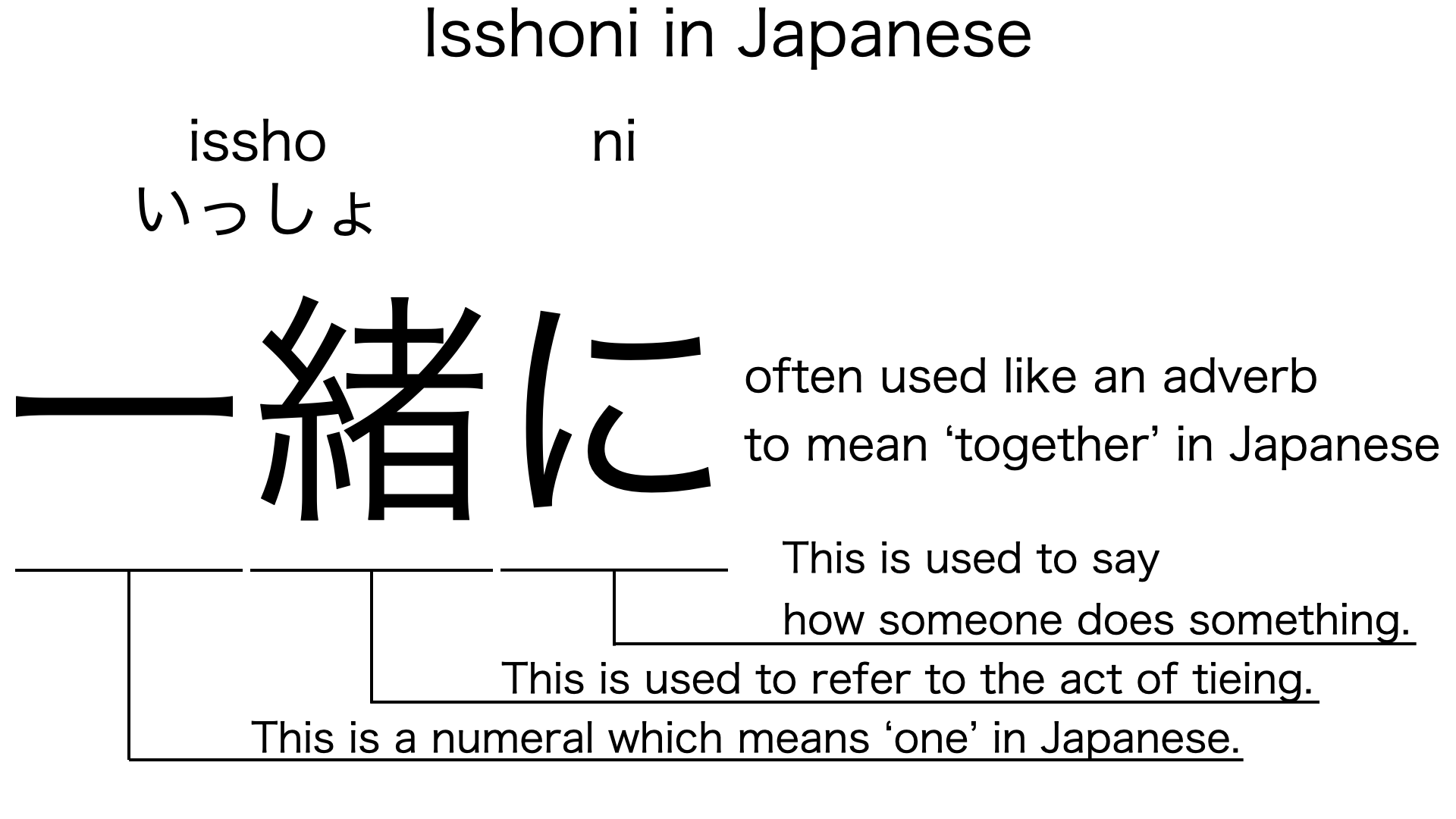What does “isshoni” mean in Japanese?
Native speakers say “isshoni” to mean ‘together’ in Japanese. Perhaps, some Japanese learners know this phrase as it is sometimes used in Japanese conversations. In this blog post, however, I will explain it in detail based on its components. And also, I will explain how to use it through example sentences. My explanations would help Japanese learners understand “isshoni” more clearly. Then, let’s get started!
Contents
Definition and meaning of “isshoni”
Let me start with the definition and meaning of “isshoni”.
- isshoni – 一緒に (いっしょに) : a phrase often used like an adverb to mean ‘together’ in Japanese.
The definition and meaning are simple and clear, I think. To understand this phrase more clearly, however, let me explain its components in detail, one by one.
What does “isshoni” literally mean in Japanese?
“Isshoni” consists of the following three components:
- 一 : a kanji character often used as a numeral to mean ‘one’ in Japanese.
- 緒 : a kanji character occasionally used to refer to the act of tieing or binding.
- に : a case particle used to say how someone does something.
From these three components, we can understand that “isshoni” literally refers to the way things are tied and become one. This literal interpretation is not completely in line with the actual meaning, but still very close, I think.

When we meet new Japanese phrases, we should check their components in detail to understand their meanings clearly and deeply. In many cases, components tell us a lot about the meanings of the phrases they form. Actually, here, we could get the better understanding of “isshoni” through the detailed check above.
So far, I’ve explained the definition and meaning of “isshoni” together with its components. Then, let me explain how to use it through the example sentences below.
Example #1: how to say “together” in Japanese
kondo isshoni tokyo ni iko u – 今度一緒に東京に行こう (こんどいっしょにとうきょうにいこう)
Let’s go to Tokyo together next time!
Below are the new words used in the example sentence.
- kondo – 今度 (こんど) : a noun but often used like an adverb to mean ‘next time’ in Japanese. In the example, this is used like an adverb at the beginning of the sentence to mean ‘next time’ in Japanese.
- tokyo – 東京 (とうきょう) : a noun meaning ‘Tokyo’ in Japanese.
- ni – に : a case particle used to say where someone or something goes. In the example, this is used after “tokyo” to say where the speakers will go next time.
- iko – 行こ (いこ) : one conjugation of the verb, “iku“, which means ‘to go’ in Japanese. In the example, it has been conjugated for the better connection with its following word.
- u – う : an auxiliary verb used after a verb to make its volitional form. In the example, this is used after “iko” to make its volitional form, “iko u”, which can mean “let’s go” in Japanese.
This is a typical usage of “isshoni”. In this example, it works like an adverb in the middle of the sentence to mean ‘together’ in Japanese.
Example #2: another example of “isshoni”
kanojo wa ringo to momo wo isshoni tabe ta – 彼女は林檎と桃を一緒に食べた (かのじょはりんごとももをいっしょにたべた)
She ate an apple and a peach together.
Below are the new words used in the example sentence.
- kanojo – 彼女 (かのじょ) : a pronoun meaning ‘she’ in Japanese.
- wa – は : a binding particle working as a case marker or topic marker. In the example, this works after “kanojo” to make the subject in the sentence.
- ringo – 林檎 (りんご) : a noun meaning ‘apple’ in Japanese. This can also work as plural. Learn more about Japanese plural.
- to – と : a parallel particle used to join two nouns. In the example, this is used to join “ringo” and “momo”. The formed phrase means ‘an apple and a peach’ in Japanese.
- momo – 桃 (もも) : a noun meaning ‘peach’ in Japanese. This can also work as plural.
- wo – を : a case particle used to make the object word in a sentence. In the example, this is used after “ringo to momo” to make the object in the sentence.
- tabe – 食べ (たべ) : one conjugation of the verb, “taberu“, which means ‘to eat’ in Japanese. In the example, it has been conjugated for the better connection with its following word.
- ta – た : an auxiliary verb used after a verb, adjective, or auxiliary verb to make its past tense form. In the example, this is used after “tabe” to make its past tense form, “tabe ta”, which means ‘ate’ in Japanese.
This is another example of “isshoni”. When we want to mean ‘together’ in Japanese, this phrase is always a very good option.
Summary
In this blog post, I’ve explained the definition and meaning of “isshoni” in detail together with its components. And also, I’ve explained how to use it through the example sentences. Let me summarize them as follows.
- isshoni – 一緒に (いっしょに) : a phrase often used like an adverb to mean ‘together’ in Japanese. This phrase literally refers to the way things are tied and become one. This literal interpretation is not completely in line with the actual meaning, but still very close, I think.
Hope my explanations are understandable and helpful for Japanese learners.
Leave a Reply